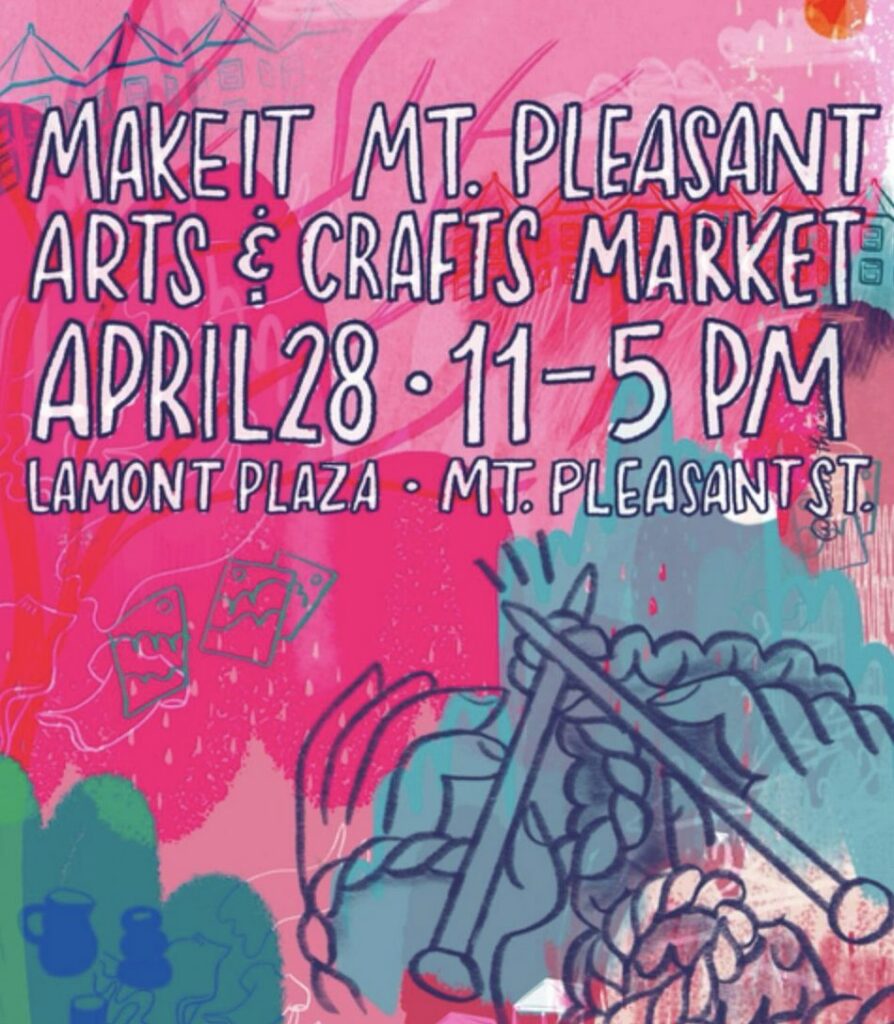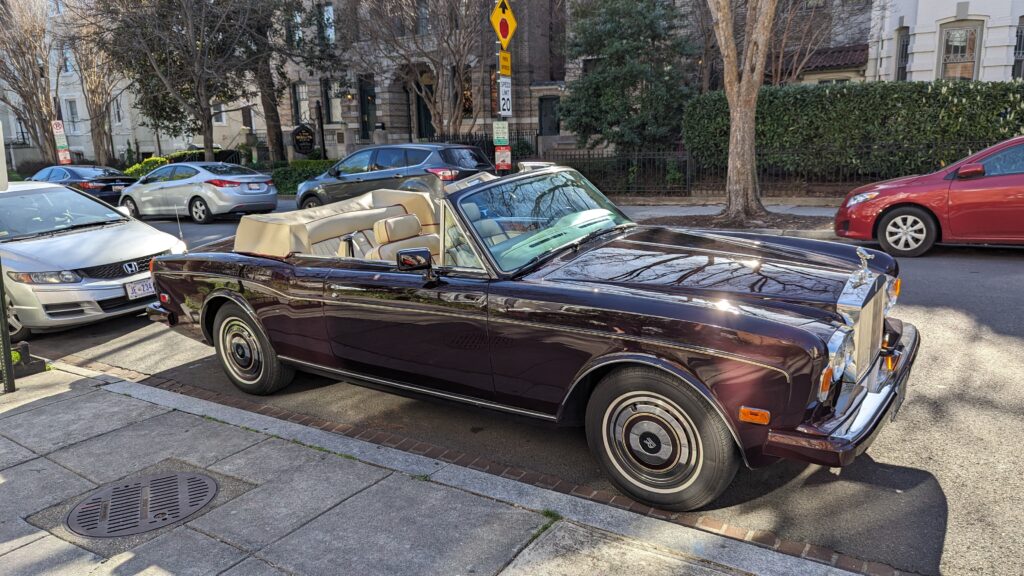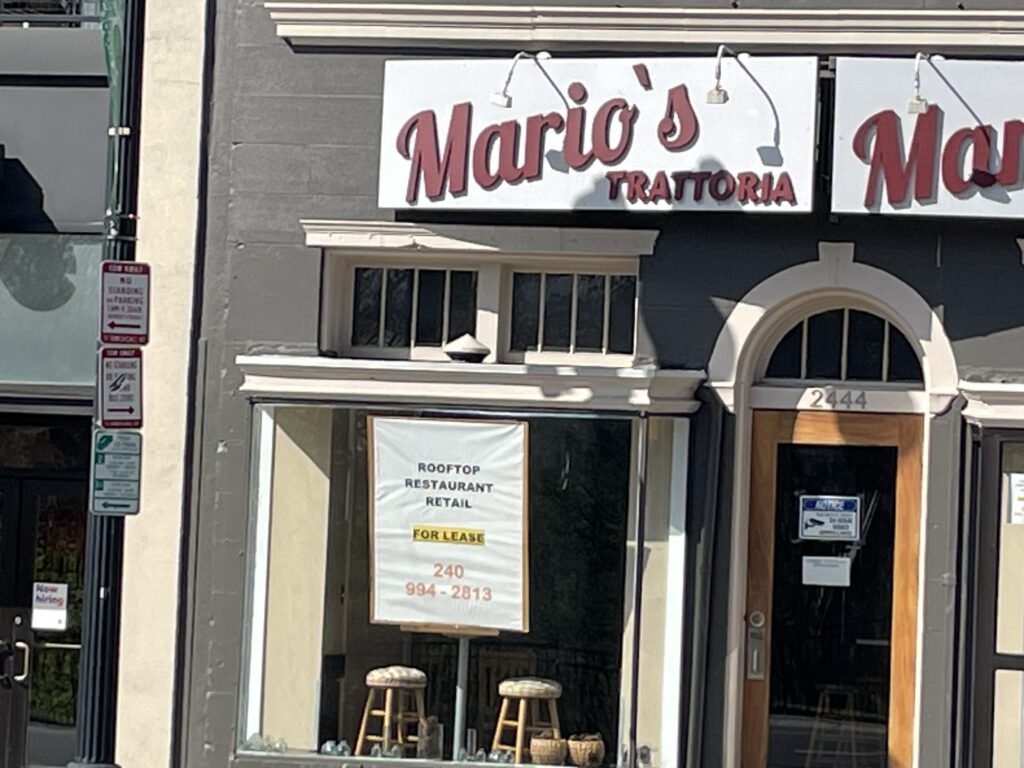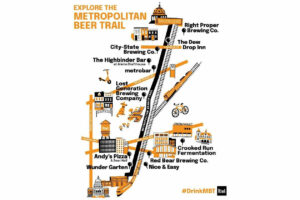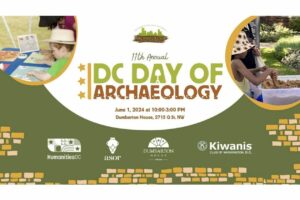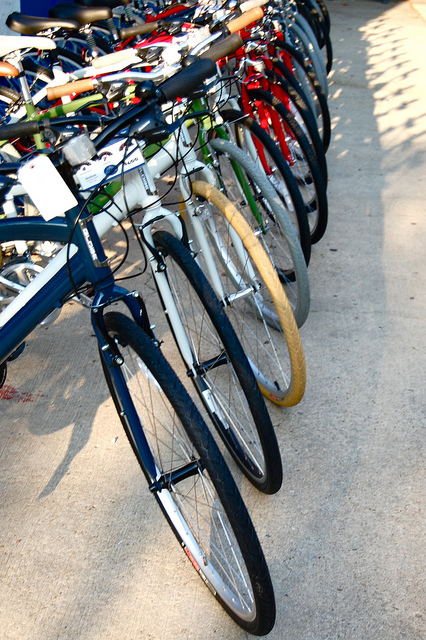
Photo by PoPville flickr user JRoseC
The following was written by Biking around Town’s Josh Nadas (@dcliterate). Josh is a daily bike commuter & avid rider who lives in Mount Pleasant.
How to size a bike
When I worked at the bike shop, my old boss used to say that a bike that does not fit you isn’t worth a nickel. I agree, so here are some techniques to help you quickly identify if a bike fits you or not. One important measure is: can you stand over the bike comfortably? Ideally, you want about an inch of clearance. You can measure this by straddling the top tube of the bike with your feet flat on the ground. Grab the seat with one hand and with the other grab the stem (the part that holds the handlebars) and gently lift the bike underneath you. Look down or have a friend look down to see how much clearance is under the tires. If you have an inch or less, that’s a good sign. If there is more than an inch, the bike may be too small. If you can’t lift the bike or worse, if standing over the bike hurts, it may be too big.
This is an important measure because when you get on and off the bike, you need plenty of clearance. Think about a quick stop where you hop off the bike, you would not want to land on the top tube. That would be painful. So, make sure you can clear the top tube, without having too much clearance. That’s an indication of a decent fit.
The next important measure of a bike is length. This depends a lot more on the type of bike (mountain, road, hybrid…) and it’s hard to give good universal advice. Additionally, you can “fit” length a little bi with stem and seat adjustments. One indicator of a good fit on a road, mountain, or fitness bike is that your back is at a 45 degree angle. It’s helpful to take a test ride and have someone else look at you ride, or take a picture of you riding. Additionally, pay attention to how comfortable riding is during your test ride. If the bike is comfortable, then that’s a good indication. The longer you can go on a test ride, the better, you’ll get the best sense of how the bike feels.
How to quickly check some key components
It’s my opinion that the two most important things to check when buying a used bike are the wheels and the brakes. The wheels are important because if you buy a bike (that you expect to actually ride) you want the wheels to be in good shape, or they could be expensive to repair or replace. The brakes are important for safety reasons. Even if the bike shifts poorly or not at all, if the wheels roll and the brakes work you should be able to make it home okay. Here are some quick tips on how to check these two components out.
Wheels are round. Duh. However, they are not always perfectly round. Sometimes they wobble left and right, or up and down. Your job is to determine if they wobble, and how much they wobble, and if it’s a good idea to buy the bike. The first step is to flip the bike upside down and balance it on the seat and handlebars, so you can spin the wheels and observe the results. Crouch down and look at the rim of the wheel near the brakes. Since the brakes are not moving, you can use them as a visual reference to determine if the wheel wobbles. First look for any left-right movement, then look for up-down movement. A small amount of movement might be acceptable, a large amount should not be. Any movement is going to cost you time or money to fix, so the less movement the better. Finally, stop the wheel from spinning gently and grab and squeeze the spokes going around the wheel. In doing so, you are trying to make sure that nothing is very lose. A single or couple of lose spokes is a very bad sign. After you have checked out the wheels – take a look at the brakes.
Brakes have two main parts, the lever (the part by the handlebars) and the caliper (the part that squeezes the wheel). While we can’t go into the finer points of all brakes in this article, I do want to explain how to see if the brakes are reasonably well adjusted. Flip the bike back upright (if you have not done so already), and standing next to the bike, roll it forward without grasping the brakes. Try and see if the brakes drag on the wheels. If they are dragging, that’s not a good sign, and they will need to be adjusted. Using the brake levers one at a time, squeeze them. If they compress firmly and about halfway to the bar (less is okay), and the bike stops, you should be okay. It’s worrisome if you grab the lever and pull it all the way back to the handlebar (even if the bike stops), or if pulling the lever fails to produce any braking power. Depending on the rest of the bike, and if you need to ride it right away, crappy brakes may not be a deal breaker, but you need to know if they work or not.
How to avoid buying a stolen bike
Bike thieves suck, they can ruin more than an afternoon. Here are my tips on avoiding buying a stolen bike. You have to be the judge of these factors, if something seems fishy, it probably is. Your intuition is your best guide here.
The seller should know things about the bike. When they bought it, how long they owned it, problems the bike gave them, how much they liked riding it, why they are selling it, ect. Ask some questions. Most of the time, the seller will probably be happy to answer, and willing to engage in a conversation about bikes, and why they are awesome.
The bike should fit the seller (usually). It does happen that someone is selling a bike they legally own that does not fit them, but most of the time people sell their old bike. So, if a short person is selling a tall bike or vice versa, maybe ask who used to ride the bike. It will probably be another family member, but it’s an innocent question to ask in order to determine the vintage / usage of the bike.
If the deal is outrageously too good to be true, than it is. In my opinion it’s still okay to buy it, as long as you do your due diligence after you buy it. Check with the police using the serial number, check craigslist for stolen bike alerts, check popville for stolen bike alerts, ect. If you can get the bike back to the owner, they are probably going to compensate you for your initial cash outlay. I know that I would. And, there are sometime just magical situations out there, just be sure to check around first. If you buy it, and you can’t find the original owner, then you can feel good about your find.
If the advertisement uses bad grammar, crappy photos, makes you meet on a street corner, can’t tell you any useful information about the bike, or if there are serious discrepancies between the ad and the actual bike, those are all worrisome signs.
I hope that this helps you in your quest for a new bike!
Recent Stories
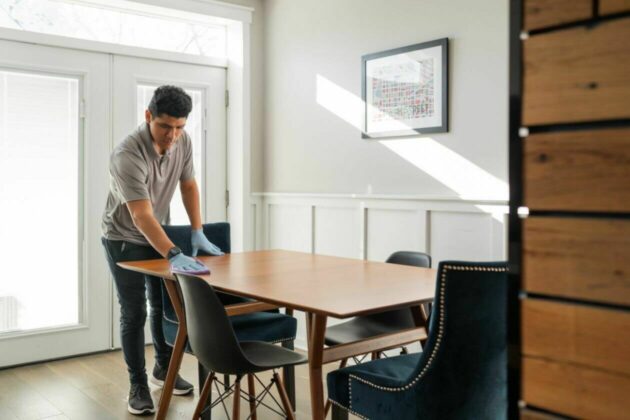
For many remote workers, a messy home is distracting.
You’re getting pulled into meetings, and your unread emails keep ticking up. But you can’t focus because pet hair tumbleweeds keep floating across the floor, your desk has a fine layer of dust and you keep your video off in meetings so no one sees the chaos behind you.
It’s no secret a dirty home is distracting and even adds stress to your life. And who has the energy to clean after work? That’s why it’s smart to enlist the help of professionals, like Well-Paid Maids.

Unlock Peace of Mind for Your Family! Join our FREE Estate Planning Webinar for Parents.
🗓️ Date: April 25, 2024
🕗 Time: 8:00 p.m.
Metropolitan Beer Trail Passport
The Metropolitan Beer Trail free passport links 11 of Washington, DC’s most popular local craft breweries and bars. Starting on April 27 – December 31, 2024, Metropolitan Beer Trail passport holders will earn 100 points when checking in at the
DC Day of Archaeology Festival
The annual DC Day of Archaeology Festival gathers archaeologists from Washington, DC, Maryland, and Virginia together to talk about our local history and heritage. Talk to archaeologists in person and learn more about archaeological science and the past of our


